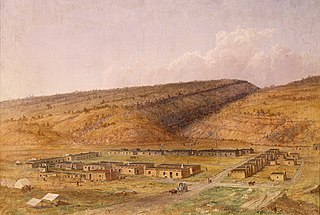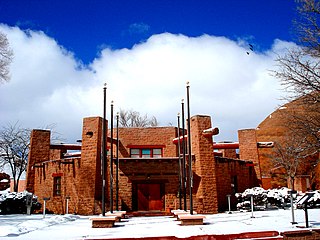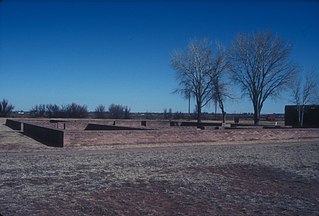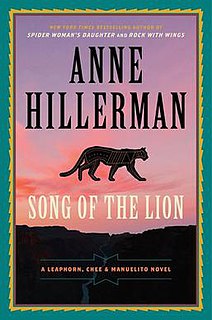
Fort Defiance is a census-designated place (CDP) in Apache County, Arizona, United States. It is also located within the Navajo Nation. The population was 3,624 at the 2010 census.

Ganado is a chapter of the Navajo Nation and census-designated place (CDP) in Apache County, Arizona, United States. The population was 1,210 at the 2010 census.

Window Rock is a census-designated place that serves as the seat of government and capital of the Navajo Nation, the largest territory of a sovereign American Indian nation in North America. It lies within the boundaries of the St. Michaels Chapter, adjacent to the Arizona and New Mexico state line. Window Rock hosts the Navajo Nation governmental campus which contains the Navajo Nation Council, Navajo Nation Supreme Court, the offices of the Navajo Nation President and Vice President, and many Navajo government buildings.

The Navajo Nation is a American Indian territory covering about 17,544,500 acres, occupying portions of northeastern Arizona, southeastern Utah, and northwestern New Mexico in the United States. This is the largest land area retained by an indigenous tribe in the United States, with a population of 173,667 as of 2010.

The Long Walk of the Navajo, also called the Long Walk to Bosque Redondo, refers to the 1864 deportation and attempted ethnic cleansing of the Navajo people by the United States federal government. Navajos were forced to walk from their land in what is now Arizona to eastern New Mexico. Some 53 different forced marches occurred between August 1864 and the end of 1866. Some anthropologists claim that the "collective trauma of the Long Walk...is critical to contemporary Navajos' sense of identity as a people".

The Heard Museum is a private, not-for-profit museum located in Phoenix, Arizona, United States, dedicated to the advancement of American Indian art. The museum presents the stories of American Indian people from a first-person perspective, as well as exhibitions of traditional and contemporary art by American Indian artists and artists influenced by American Indian art. The Heard Museum collaborates with American Indian artists and tribal communities on providing visitors with a distinctive perspective about the art of Native people, especially those from the Southwest.

The Navajo Nation Zoological and Botanical Park is located in Window Rock, Arizona, the capital of the Navajo Nation. It is the only tribally owned zoological park in the United States and is notable among zoological facilities in that it labels its exhibits in the Native American Indian language of Navajo. Having been operated by the Navajo Nation Parks & Recreation Department since its inception in the early 1960s, it became part of the Navajo Nation Department of Fish and Wildlife in September 2006.

Chief Manuelito or Hastiin Chʼil Haajiní (1818–1893) was one of the principal headmen of the Diné people before, during and after the Long Walk Period. Manuelito is the diminutive form of the name Manuel, the Iberian variant of the name Immanuel; Manuelito roughly translates to Little Immanuel. He was born to the Bit'ahnii or ″Folded Arms People Clan″, near the Bears Ears in southeastern Utah about 1818. As many Navajo, he was known by different names depending upon context. He was Ashkii Diyinii, Dahaana Baadaané, Hastiin Ch'ilhaajinii and as Nabááh Jiłtʼaa to other Diné, and non-Navajo nicknamed him "Bullet Hole".

Fort Sumner was a military fort in New Mexico Territory charged with the internment of Navajo and Mescalero Apache populations from 1863 to 1868 at nearby Bosque Redondo.

The Navajo Nation Police is the law enforcement agency on the Navajo Nation in the Southwestern United States. It is under the Navajo Division of Public Safety. It is headed by a Chief of Police, six Police Captains and eight Police Lieutenants. It includes: Internal Affairs, Patrol, K-9 Unit, Police diving, Tactical Operations Team, Traffic Unit, Fiscal management, Recruitment, and Training Divisions. The Navajo Nation Police are responsible for seven districts: Chinle, Crownpoint, Dilkon, Kayenta, Shiprock, Tuba City, and Window Rock. There are also several substations in each district ranging from one-man substations or up to five officers each. Currently, there are 210 sworn police officers(134 patrol), 28 criminal investigators and 279 civilians, acting as support staff for the department. There are approximately 1.9% police officers per 1,000 people and one officer is responsible for patrolling 70 square miles (180 km2) of reservation land. The Navajo Nation Police are funded by federal contracts and grants and general Navajo Nation funds. This police department is one of only two large Native American police Departments with 100 or more sworn officers in the United States.

The Navajo are a Native American people of the Southwestern United States.

The Fort Apache Indian Reservation is an Indian reservation in northeastern Arizona, United States, encompassing parts of Navajo, Gila, and Apache counties. It is home to the federally recognized White Mountain Apache Tribe of the Fort Apache Reservation, a Western Apache tribe. It has a land area of 1.6 million acres and a population of 12,429 people as of the 2000 census. The largest community is in Whiteriver.

The Navajo Scouts were part of the United States Army Indian Scouts between 1873 and 1895. Generally, the scouts were signed up at Fort Wingate for six month enlistments. In the period 1873 to 1885, there were usually ten to twenty-five scouts attached to units. United States Army records indicated that in the Geronimo Campaign of 1886, there were about 150 Navajo scouts, divided into three companies, who were part of the 5,000 man force General Nelson A. Miles put in the field. In 1891 they were enlisted for three years. The Navajos employed as scouts were merged into regular units of the army in 1895. At least one person served almost continuously for over twenty-five years.

Barboncito or Hastiin Dághaaʼ was a Navajo political and spiritual leader.

The Wailing Wind is the fifteenth crime fiction novel in the Joe Leaphorn/Jim Chee Navajo Tribal Police series by Tony Hillerman, first published in 2002. It is a New York Times best-seller.

The Sinister Pig is the sixteenth crime fiction novel in the Joe Leaphorn / Jim Chee Navajo Tribal Police series by Tony Hillerman, first published in 2003. It was a New York Times best-seller.

Skeleton Man is the seventeenth crime fiction novel in the Joe Leaphorn / Jim Chee Navajo Tribal Police series by Tony Hillerman, first published in 2004. It was a New York Times best-seller

The Treaty of Bosque Redondo was an agreement between the Navajo and the US Federal Government signed on June 1, 1868. It ended the Navajo Wars and allowed for the return of those held in internment camps at Fort Sumner following the Long Walk of 1864. The treaty effectively established the Navajo as a sovereign nation.

Song of the Lion is a 2017 release and the third Leaphorn/Chee mystery written by Anne Hillerman, daughter of the series originator Tony Hillerman. The title is derived from Navajo culture, which speaks of a cougar, Náshdóítsoh, who protects the Navajo people. After her father's 2008 death, Anne continued the series. The Navajo Nation on which the story takes place, is a geographical area that spans 27,000 square miles over the connecting borders of the US states of Arizona, New Mexico and Utah. According to the NN itself, it encompasses 500 Indian tribes on 318 reservations.

Spider Woman's Daughter is a 2013 release and the first Leaphorn/Chee mystery written by Anne Hillerman, daughter of the series originator Tony Hillerman. The title of the book is derived from Native American legends. Spider Woman was the one who taught the Navajo people how to weave. Officer Bernadette Manuelito is the daughter of a weaver, and married to Officer Jim Chee. He nicknamed her "Spider Woman's Daughter" for her ability to weave together a complex array of evidence to solve a crime. In her debut effort to continue the series, Anne Hillerman has given the reader an exceptionally detailed plot and long list of characters. One reviewer at Goodreads.com counted 46 named characters.





















